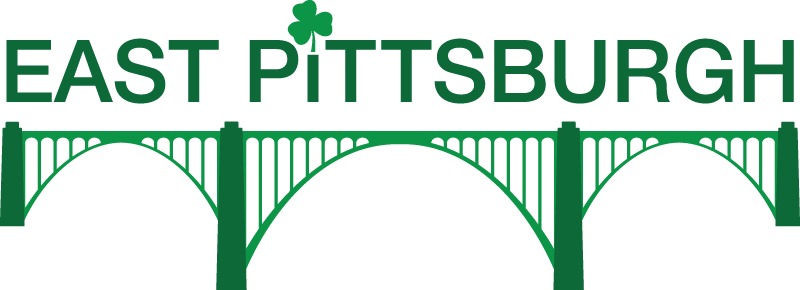East Pittsburgh is a close knit diverse community covering a one half square mile area nine miles east of the city of Pittsburgh, Pennsylvania.
It is flanked on one side by a westward flowing stream called Turtle Creek which flows into the Monongahela River and flows onward to become part of the three rivers that meet at the Point in Pittsburgh. The other two rivers are the Allegheny and the Ohio.
Just as Turtle Creek, which continues to play a larger role in the life of the three rivers, so does the small borough of East Pittsburgh influence the history of people worldwide through its talented people, manufacturing abilities, and inventions.
This Turtle Creek valley area is rich in history. In the early days, it was inhabited by Indians. The first non-Indian settler is believed to be John Frazer, a trader who built a cabin at the mouth of the creek in 1748. George Washington and Christopher Gist blazed the first colonial trail through this area that is now a part of East Pittsburgh. Folklore tells us of George Washington’s interest in Frazer’s daughter, whom he stopped to see at the cabin.
Tiny settlements began to appear – a store, blacksmith shop, church, pioneer farmers, and hostelry.
The main territory was originally divided into two large farms, one of which is now Bessemer Terrace and the other down below in the valley. The original farmhouse on the Terrace stood on the back lot at the corner of Main and Franklin Streets. The first small community settlements were in Port Perry and in Brinton. Early residents had to either climb the hill or cross through Frog Hollow Swamp down in the valley to obtain milk, butter, and other family needs. Over time, the Terrace farmland was divided into two smaller farms.
Mining and shipping were increasing which made railroading the chief industry of this period.
Highly developed shipping facilities for coal, lumber, and farm products favorably influenced George Westinghouse to locate his industrial plants in Wilmerding, Turtle Creek, and East Pittsburgh.
The origin of East Pittsburgh dates back as far as 1871 when part of the First Ward was laid out in what was designated as the “Patrick Plan” that was located below the Terrace. It wasn’t until 1890 that old “Brinton,” the first principal town plot, was adopted.
The first marked change came after the Pennsylvania Railroad bought twenty acres in order to straighten its passenger tracks. They laid tracks over Black Meadows and changed the course of Turtle Creek while seeking a right of way for their lines. This is the site where the Westinghouse plant now stands.
The first units of the Westinghouse Electric & Manufacturing Co. were built in 1894. This was followed by the building of the town proper. East Pittsburgh became a fast-growing town with expanding businesses and a large increase in population. The Pennsylvania Railroad established a station in East Pittsburgh and the trolley lines were extended to the town.
In 1894, a petition was presented to court requesting the incorporation of East Pittsburgh Borough and was granted on April 16, 1895. Wilson Marks was elected as Burgess of the new borough.
The first transmission from pioneer radio station KDKA- AM was made from the Westinghouse plant in East Pittsburgh.
In 1928, an early demonstration of a new medium (television) was conducted at the Westinghouse laboratories in East Pittsburgh. Eventually, the new medium became known as “television.” Vladimir Zworykin worked for Westinghouse Electric Corporation at that time. He lived in the borough of Wilkinsburg.
The East Pittsburgh School District included Bessemer Avenue Elementary School and East Pittsburgh Junior/Senior High School on Howard Street. East Pittsburgh’s school colors were green and white, and its athletic teams were called the Shamrocks.
During the 1970-71 school year, the East Pittsburgh School District was merged, by court order, with the neighboring Turtle Creek School District for the following year. In the final basketball game between the two rivals, the Shamrocks defeated Turtle Creek, 65-63.
